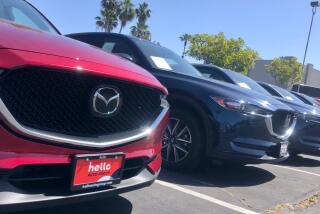Top Automakers Agree to SUV-Crash Safety Changes
- Share via
WASHINGTON — The world’s major automakers Thursday announced a voluntary program of design changes intended to reduce deaths and injuries among people in cars hit from the side or head-on by larger sport utility vehicles and pickups.
While praising the industry’s commitment, federal safety officials said the government intends to go ahead with a mandatory requirement that would improve protection in front-to-side crashes, the most dangerous type of collision between SUVs and cars.
Automakers “not only tackled this complex problem, but did it in a very timely fashion,” said Rae Tyson, a spokesman for the National Highway Traffic Safety Administration. “They certainly should feel a sense of accomplishment for bringing together disparate factions and agreeing on a plan.”
Fifteen companies -- from General Motors to South Korea’s Kia Motors -- agreed to a common set of industry standards. Design changes would be made in all types of vehicles.
“This is the first time in history that you had global automakers working on safety at this level,” said Eron Shosteck, a spokesman for the Alliance of Automobile Manufacturers, the industry’s lobbying arm in Washington.
For better protection in front-to-side crashes, automakers will phase in side air bags that shield the head and torso. Side impact safety would be upgraded for all types of vehicles, not only cars. To reduce risks in head-on crashes, manufacturers will lower the bumpers of SUVs or add a barrier to prevent them from riding over cars. Companies may use different designs to meet the new standards.
About 25% of all new vehicles already meet the side-impact standard, and about half meet the criteria for frontal crashes, Shosteck said. Automakers pledged that virtually all new vehicles would meet both standards by Sept. 1, 2009.
The cost could be hundreds of dollars per vehicle, depending on the extent of the design changes. Studies have shown that side air bags reduce fatalities in side-impact crashes by 45%.
A small number of models, mainly high-end sports cars, would be exempt from the new standards because the design changes would be impractical or too costly. But small passenger cars like the Volkswagen Beetle would be covered.
Automakers are expected to quickly start advertising which of their models comply. “Each company is going to tout its vehicles that meet the standards -- and point out competitors that don’t,” Shosteck said.
Federal officials said they would take a close look at the technical details. “This is so complex, we really aren’t in a position to say anything very specific,” Tyson said. “I can’t speculate now on whether [the industry’s] plan is going to take them where they want to go.”
Until recently, automakers had downplayed the safety problems of SUVs, which can overpower smaller vehicles in crashes and are themselves prone to roll over in sudden turning maneuvers.
Earlier this year, safety administration chief Jeffrey Runge chastised the industry, saying the disproportionate death toll for car passengers in crashes with SUVs and pickups was not acceptable. When an SUV strikes a car on the side, the car driver is 22 times more likely to die than is the driver of the SUV. A pickup truck is even deadlier: In those crashes, car drivers are 39 times more likely to be killed.
Fearing a new series of government regulations, automakers promised Runge and Congress that they would address the safety concerns voluntarily. The industry sought the assistance of the Insurance Institute for Highway Safety, a testing organization that helped to develop the new standards and endorsed them Thursday.
Consumer groups said the industry’s action was overdue, and they urged the government not to abandon its regulatory efforts.
“There is no doubt in my mind that the industry would not be moving forward had federal regulators not threatened to impose mandatory standards,” said Sally Greenberg, a lawyer for Consumers Union, which publishes Consumer Reports. “This doesn’t come out of the blue.”






